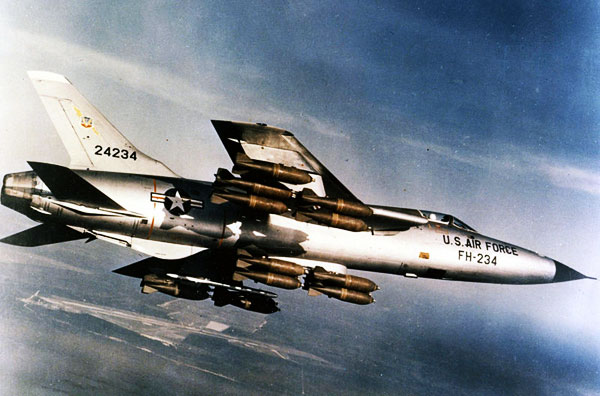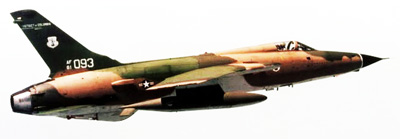Republic F-105 Thunderchief


F-105 Thunderchief
 By 1953, the Air Force had gained
enough experience in jet operations to
precisely define the requirements for a tactical fighter-bomber. Thus, the Republic F-
105 became the first plane of its type designed specifically for the role. Virtually half
fighter-half bomber, the F-105 design included a bomb-bay capable of containing a
nuclear weapon.
By 1953, the Air Force had gained
enough experience in jet operations to
precisely define the requirements for a tactical fighter-bomber. Thus, the Republic F-
105 became the first plane of its type designed specifically for the role. Virtually half
fighter-half bomber, the F-105 design included a bomb-bay capable of containing a
nuclear weapon.
In March 1953, Republic received an order for thirty-seven XF-105A's. The mock-up was ready for inspection seven months later. With the conclusion of the Korean War in mid-1953, the need for the new fighter was reduced, and consequently' the order was cut to fifteen aircraft, then to only three. Finally, the figure was restored to fifteen units.
While the first two XF-105A's were under construction, the difficulties en' countered by the Convair F-l02 were being studied by Republic. It was apparent that the same transonic drag rise problem discovered during the F-102 Program could very well affect the performance of the F-105. New fuselage contours were drawn up, Thunderchief Republic but the first two airframes were nearly completed so the third plane received the revised shape and was designated F-1058. In addition to the area-ruling of the fuselage, a distinctive new two-dimensional air intake was mounted to the wing giving a unique "M" shape to the wing planform.
The first two F-105's were powered by a 10,000 lb. Pratt & Whitney J57-P-25; and on October 22, 1955, the Thunderchief began its flight testing, exceeding Mach 1 in the process. However, the transonic drag problem was confirmed as the PrototyPe could only achieve Mach 1.2 in its unmodified form. The recontoured F-105B joined the test program in May 1956, and made its first flight on the 26th of that month. Employing a Pratt & Whitney J75- P-3 of 21,500 lbs. with afterburner, the F-105B reached a speed of 1,420 mph (Mach 2.t5).

Seventy-five F-105B's were built, this type entering the Air Force inventory on May 27, 1958. The F-105D carries a General Electric FC-5 fully integrated automatic flight and fire control system giving it all-weather capabilities. A total of 610 of these make it it the major production version. Externally, it is 1 foot 3 inches longer than the "8."
The F-105F is a two-place Thunderchief similar to an earlier F-1058 which was cancelled while on the assembly line. The F' 105F did reach the production line, however, and 143 of the two-seaters were completed. It was designed to help train pilots in the operation of the complex weapon system; but it became an oPerational combat weapon in Vietnam where the second seat was occupied by the operator of electronic counter-measures gear. In this role, an F-105F would accompany a flight of conventional Thunderchiefs which were armed with bombs. The two- seater mounted radar jamming gear to confuse the enemy's radar-directed anti-aircraft guns and SAM missiles.
In Vietnam, the F-105's were used as bombers-the usual load exceeded by fifty percent the amount carried by a World War II B- 17. An extra fuel tank was fitted into the spacious bomb bay while uP to 12,000 lbs. of bombs were suspended from five hardpoints. Though primarily used as a bomber, the Thunderchief still scored its share of downed Migs, 29 of which felt the bite of the big plane. The F-105D's wing measures 34 feet 11 inches, tip to tip. Length is 64 feet 3 inches and height is 19 feet 8 inches. Wing area is 385 square feet. With its afterburning J75-P-9V, the F-105D has a maximum speed of 1,390 mph at 50,000 feet. Empty weight is 27,500 pounds, normal weight is 38,034 pounds, gross weight is 52,546 pounds. The built-in armament of the F-105D consists of one 20 mm M61 Vulcan cannon with 1,029 rounds. A great variety of missiles can be suspended from the Thunderchief's hardpoints, the actual distribution would be determined by the particular mission at hand.

Republic F-105
The F-105 was the final product of Republic's 'Thunder Factory' and the successor to the F-84 Thunderjet and the F-84 Thunderstreak. The air- craft was in much the same mould-a dedicated fighter-bomber optimized for the delivery of a single nuclear weapon against a tactical target. It also had respectable conventional attack capabilities.
The type was developed as a private venture and was intended to be capable of exceeding Mach 2, carrying its single nuclear bomb internally, or heavier loads of iron bombs externally. It was therefore of advanced design, with a highly-swept wing, forward swept variable geometry intakes, full-span leading edge flaps, ailerons for low-speed roll control and spoilers for high speed. The aircraft also had an automatic flight control system and an afterburning Pratt and Whitney J75 turbojet engine.
The first of two prototypes made its maiden flight on October 22, 1,955, and the production F-105B entered service in 1958. Only 78 production F-105Bs were built. The D-model was much improved, with a more powerful engine, strengthened airframe and undercarriage. It also had a new integrated flight and fire control system, including a new search and ranging radar in the extended nose.
Republic built 610 F-105Ds, the first making its maiden flight on June 9, 1959. From the -25RE production block, the F-105Ds were delivered with extra hardpoints for 12 more conventional weapons. Early aircraft were subsequently brought up to the same standards.
During its early career, the F-105 suffered a succession of problems, and the type was grounded several times. Some of the problems were solved by the introduction of a two-seat trainer version, the F-105F.
The F-105 flew 75 per cent of the airstrikes against North Vietnam between 1964 and 1969. It carried more ordnance in the Vietnam War than any other aircraft type, from the Navy or the Air Force. They suffered correspondingly heavy losses but demonstrated great resilience. Many pilots owed their lives to the aircraft's robust structure and reliable systems. F-105s also shot down 24 enemy MiGs during the war.
The F-105 lacked sufficient precision capability for some conventional missions. The aircraft were often dispatched to 'bomb on command' with a B-66 'lead ship'. To remedy some of these deficiencies, 30 F-105Ds received Thunderstick II modifications, with a new inertial navigation system, LORAN, a solid-state version of the R-14A radar, and Doppler.
The best known conversions were the 612 two-seat F-105Fs which were converted to F-105G standards as dedicated defense suppression aircraft. They were rushed into service to counter the North Vietnamese SAM threat, and were equipped to detect, identify, locate and attack enemy air defense and SAM radars. This type was the last in frontline service. After retiring in 1978 they served with the Georgia Air National Guard until May 1983.
Thunderchief
 The Republic F-105 Thunderchief, was a supersonic fighter-bomber used by the United States Air Force. The Mach 2 capable F-105 bore the brunt of strike bombing over North Vietnam during the early years of the Vietnam War. Originally designed and deployed as a single seat aircraft, a two-seat Wild Weasel version was later developed for use in the specialized Suppression of Enemy Air Defenses (SEAD) role against surface-to-air missile sites. It was commonly known as the Thud by its crews.
The Republic F-105 Thunderchief, was a supersonic fighter-bomber used by the United States Air Force. The Mach 2 capable F-105 bore the brunt of strike bombing over North Vietnam during the early years of the Vietnam War. Originally designed and deployed as a single seat aircraft, a two-seat Wild Weasel version was later developed for use in the specialized Suppression of Enemy Air Defenses (SEAD) role against surface-to-air missile sites. It was commonly known as the Thud by its crews.
As a follow-on to the Mach 1 capable F-100, the F-105 was also armed with missiles and a cannon; however, its design was tailored to high-speed low-altitude penetration carrying a single nuclear bomb internally. First flown in 1955, the Thunderchief entered service in 1958. As the largest single-engined fighter ever employed by the USAF, the single-seat F-105 would be adapted to deliver a greater bomb load than the four-engined, 10-man strategic bombers of World War II like the B-17 and B-24. The F-105 would be best remembered as the primary strike bomber over North Vietnam in the early stages of the Vietnam War. Over 20,000 Thunderchief sorties were flown, with 382 aircraft lost (nearly half of the 833 produced) including 62 operational losses. Although it lacked the agility of the smaller MiG fighters, USAF F-105s demonstrated the effectiveness of guns, and were credited with downing 27.5 enemy aircraft.
During the war, the two-seat F-105F and F-105G Wild Weasel variants became the first dedicated Suppression of Enemy Air Defenses (SEAD) platforms, fighting against the Soviet-built S-75 Dvina/(SA-2 Guideline) surface-to-air missiles. Two Wild Weasel pilots were awarded the Medal of Honor for attacking North Vietnamese surface-to-air missile sites, with one shooting down two MiG-17s the same day. The dangerous missions often required them to be the "first in, last out," suppressing enemy air defenses and keeping them suppressed while strike aircraft accomplished their missions and then left the area.
Although the F-105 weighed 50,000 lb, the aircraft could exceed the speed of sound at sea level and Mach 2 at high altitude. It could carry up to 14,000 lb of bombs and missiles. The Thunderchief was later replaced as a strike aircraft over North Vietnam by both the F-4 Phantom II and the swing-wing F-111. However, the "Wild Weasel" variants of the F-105 remained in service until 1984, when they were replaced by a specialized F-4G "Wild Weasel V". The USAF F-4G was subsequently replaced by the USAF F-16CJ Fighting Falcon aircraft, currently employed in the SEAD role.
Specifications
Payload: 14,000 lb of weapons
|
 |
||
| A the F-105 had unique air intakes mounted in the wing roots. They were specially shaped to give high airflow at supersonic speeds. | B The Sharp Sweep of the F-105 wing
gave |
C The narrow-wasted fuselage was known as the "Coke bottle" shape. |
 |
|||
| A An air-to-air refueling probe and receptacle was fitted in the port upper fuselage | B Bomber F-105s were single seaters. The later F-105F "Wild Weasel" was specialized defense suppression aircraft with a rear cockpit for a weapons officer. | C Later F-105s had an enlarged dorsal spine, carrying defensive electronic countermeasures gear to jam missile control radars. | D The F-105D had a much improved NASARR radar, which when linked to the AN/AGS 19 fire control system allowed all-weather and night attacks. |
| E The Thunderchief could defend itself with its 20-mm Vulcan gun, and several Migs fell to the F-105. sidewinder missiles were also carried for self-defense. | F As well as carrying wing-mounted weapons, the F-105 had a large internal bomb bay that could also store additional fuel. | G External fuel tanks were usually carried when flying heavily loaded, long-ranged strikes over Vietnam. | H The J-75 turbojet was the most powerful of its day. The F-105D was fitted with the "-19W" variant, delivering more than 12 tons of thrust. |
 |
This fabulous F-105 cutaway comes in full size PDF for FREE included in your MyModels folder! |
Model is still under development 11/09/2009.


